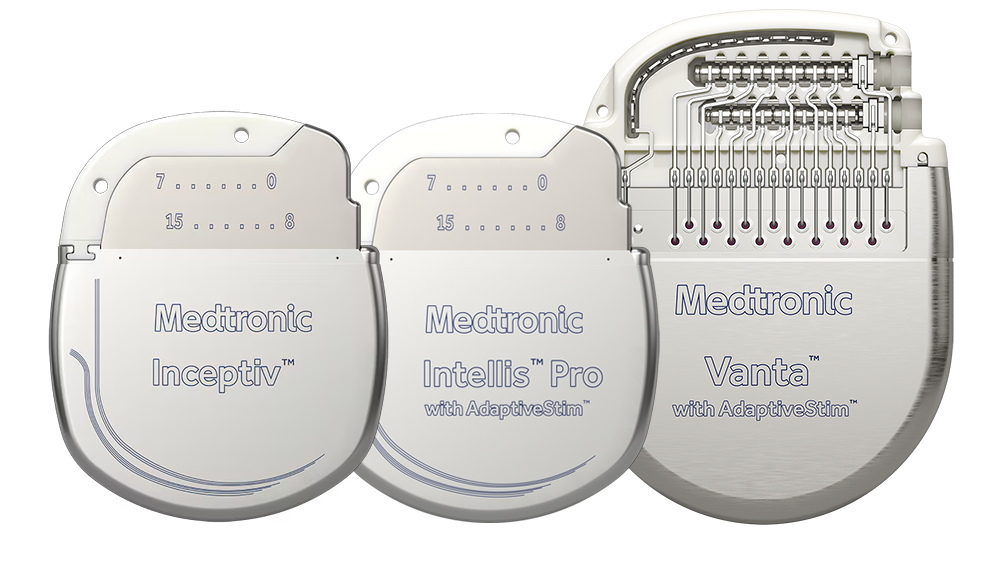Spinal cord stimulation device options
For life in motion

Potential benefits of spinal cord stimulation include:
- Proven long-term therapy for managing chronic pain1-3
- Improved ability to function4
- More effective than repeat surgeries for pain5
- Multiple studies have provided clinical evidence to suggest some patients treated with SCS may be able to reduce oral opioid consumption6-8
There are a number of choices when deciding what SCS system is right for you. Together with your doctor, select the SCS system that has the features that benefit you most.
Why choose a Medtronic device?
- Try it before you decide
- Sleek and small
- Convenient wireless programmer
- High-performing battery
- Able to have full-body MRI scans†
- Personalized treatment for your pain
456,000+
people with chronic pain worldwide have been helped by Medtronic therapy.‡
† ![]() Under specific conditions. Talk to your doctor and refer to product labeling for a full list of conditions.
Under specific conditions. Talk to your doctor and refer to product labeling for a full list of conditions.
‡ Data on file.
 |
 |
 |
|
| Options to suit your needs |
Inceptiv™ rechargeable SCS | Intellis™ rechargeable SCS | Vanta™ recharge-free SCS |
| Personalized pain relief with closed-loop sensing technology | ✔ | n/a | n/a |
| Therapy adjustments based on body position with AdaptivStim™ feature | ✔ | ✔ | ✔ |
| Full-body MRI scans† | ✔ | ✔ | ✔ |
| Small, comfortable device size | ✔ | ✔ | ✔ |
| Access to network of Medtronic support | ✔ | ✔ | ✔ |
| Industry-leading battery longevity | >95% battery capacity retained at 9 years*,2 |
Up to 9 years* | Variable, based on programming |
| Fast battery recharge | ✔ | ✔ | n/a |
| Recharge-free convenience | n/a | n/a | ✔ |
| *Recharge-free devices are parameter dependent, and longevity can vary depending on settings. |
|||
Understand the risks
Implanting the SCS system requires surgery which can have serious complications. Once the neurostimulation system is implanted, it’s possible that device complications may occur. Talk with your doctor to fully understand the risks and benefits of any therapy.
Intellis™ SCS system for quick, convenient recharging
Make recharging an easy part of your daily routine.
“Recharging for me is very simple. I put the belt on, I just plug in the recharger to the programmer, and away I go. I can sit down while I do it, I can stand up, I can walk around, I can do whatever I need to do.“
- Bryan, Intellis™ SCS patient
Fishman M, Cordner H, Justiz R, et al. Twelve-month results from multicenter, open-label, randomized controlled clinical trial comparing differential target multiplexed spinal cord stimulation and traditional spinal cord stimulation in subjects with chronic intractable back pain and leg pain. Pain Pract. 2021;21(8):912–923.
Kumar K, Taylor RS, Jacques L, et al. The effects of spinal cord stimulation in neuropathic pain are sustained: a 24-month follow-up of the prospective randomized controlled multicenter trial of the effectiveness of spinal cord stimulation. Neurosurgery. 2008;63(4):762–770; discussion 770.
Kemler MA, de Vet HC, Barendse GA, van den Wildenberg FA, van Kleef M. Effect of spinal cord stimulation for chronic complex regional pain syndrome type 1: five-year final follow-up of patients in a randomized controlled trial. J Neurosurg. 2008;108(2):292–298.
Kumar K, Taylor RS, Jacques L, et al. Spinal cord stimulation versus conventional medical management for neuropathic pain: a multicenter randomized controlled trial in patients with failed back surgery syndrome. Pain. 2007;132(1-2):179–188.
North RB, Kidd D, Shipley J, Taylor RS. Spinal cord stimulation versus reoperation for failed back surgery syndrome: a cost effectiveness and cost utility analysis based on a randomized, controlled trial. Neurosurgery. 2007;61(2):361–369.
Gee L, Smith HC, Ghulam-Jelani Z, et al. Spinal Cord Stimulation for the Treatment of Chronic Pain Reduces Opioid Use and Results in Superior Clinical Outcomes When Used Without Opioids. Neurosurgery. 2018. A non-randomized prospective cohort study of SCS patients between September 2012 and August 2015 (N=86 [n=53 on opioids]).
Sharan AD, Riley J, Falowski S, et al. Association of Opioid Usage with Spinal Cord Stimulation Outcomes. Pain Med. December 2017. A non- randomized analysis of Truven Health Marketscan databases from January 2010 to December 2014 based on the First occurrence of an SCS implant (N= 5,476).
Pollard EM, Lamer TJ, Moeschler SM, et al. The effect of spinal cord stimulation on pain medication reduction in intractable spine and limb pain: a systematic review of randomized controlled trials and meta-analysis. Journal of Pain Research. 2019:12 1311–1324. A research review summarizing SCS studies with respect to opioid use and a further meta-analysis of comparative SCS RCTs of 1 year or greater duration (N=489).
